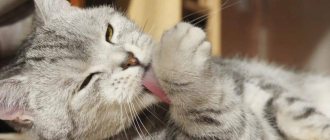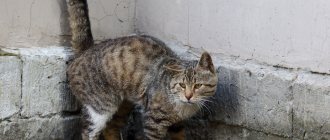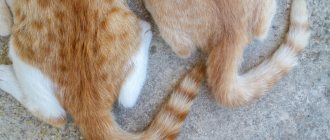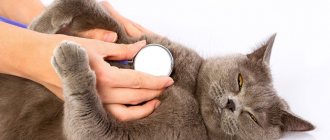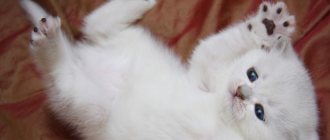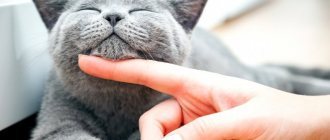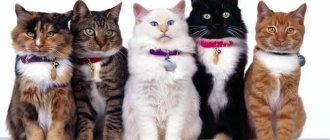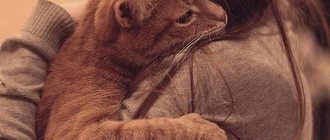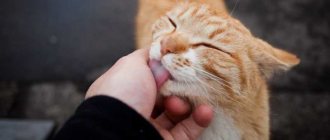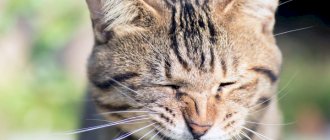Symptoms: how to determine if there is a problem
The fact that something is wrong with a cat’s tail will be visible to the naked eye.
A crease or unnatural bend will be visible at the site of injury. Also, often when injuries occur, the innervation is disrupted, and the animal is unable to move the injured part. The main signs of possible problems with a cat's tail are:
- visually noticeable fracture or disruption of integrity;
- pain when trying to touch the animal;
- traces of a bite, injury or infection are visible on the tail;
- a clearly noticeable inflammatory process and an increase in temperature, which can be detected even with a simple touch;
- the damaged part of the tail swells and swells;
- the tail hangs unnaturally;
- an open injury in which the bones are gaping;
- ensuing paralysis;
- problems with motor function of the legs are noticeable;
- problems with the toilet (either urinary and fecal incontinence appears, or the cat cannot defecate on its own).
An examination by a specialist will help you understand whether there is a fracture or whether it is a simple bruise.
Genetic abnormalities
Causing a change in the shape of the tail: crease, break, bend and knotting.
A kink is a form of tail deformation in which the next vertebra rises above the previous one, as if forming a “step up the ladder.” These deformed vertebrae have different sizes and rounded edges. Kink is a form of deformation, the opposite of a crease, - the vertebrae are located “a step down the ladder.” Bending is a form of deformation in which one or more vertebrae “pop out” beyond an imaginary line passing through the middle of the vertebrae from the base of the tail to its tip. The bodies of such protruding vertebrae may have a wedge-shaped shape. Nodulation is a form of deformation characterized by the fusion of two or more altered vertebrae (outwardly reminiscent of a dined boa constrictor).
Alas, the problems that a cat (and therefore the owner) may have with its tail do not end there. But that's another story (see Tailed problems).
So, maybe a cat doesn't really need a tail after all. But it is he who makes her grace perfect. And since only a cat knows how to hold her tail like a pipe, let this advantage remain with her!
How cats communicate using their tails
It is not always possible to understand from the face how to determine the mood of the animal and figure out what the cat wants. And it is the cat’s tail that will tell you about all the thoughts and emotions of the pet. Let's look at specific examples of why and how a cat twitches its tail:
- The four-legged pet smoothly swings its tail horizontally in different directions. Cat experts indicate this gesture as the fact that she cannot immediately make a choice between her desires. When the decision is made, the animal will calm down and stop twitching;
- if a cat lifts its tail and puts it vertically, it tells you that the pet’s thoughts are very interested in something;
- a slight twitch indicates strong affection and love for you;
- if the cat’s fifth limb is down, it means that she is bored;
- the tail is up, but the back is arched and the ears are pressed back - the cat cannot decide whether to attack or defend. He is very scared;
- the tail is in a curved arc position and the cat arches its back - it senses danger and is ready to defend itself. In this state, do not hit her and try to calm her down;
- a tail raised up (vertically) indicates that the animal is in a great mood and is ready for games and communication;
- a loosely drooping tail tells that the pet is in a calm mood, but is not inclined to communicate;
- a measured and rather strong horizontal waving of the tail indicates dissatisfaction and irritation;
- a wary animal's tail is lowered and ruffled;
- only the tip of the tail moves slightly - at the moment the pet is in an excellent mood and is happy with everything that is happening around him;
- the cat’s tail trembles and moves horizontally in different directions faster and faster - the hunt is in full swing and an attack on the prey will occur in the coming seconds;
- a vertically extended, quivering tail denotes a playful mood. It’s worth considering here that if the movements become faster and sharper, the cat beats its tail and may start meowing - the animal is getting too excited and it’s time to stop it. This is especially true when playing with small children - the danger of scratches and bites from a cat is too great;
- a tail wrapped in a ring around the body speaks of an excellent mood and trust in the surrounding world;
- the tail is raised halfway - the pet is confused and cannot determine its attitude towards a person or animal - to understand whether it is a friend or an enemy;
- fluffy tail and fur along the spine - the cat is furious;
- a vertically raised tail may mean that the cat is marking territory;
- sharp waving or tapping indicates stress and possibly pain;
- biting the tail signals the presence of parasites;
- in cold weather, cats wrap their tail in a ring around themselves, thereby reducing heat transfer;
- a vertically raised tail with a relaxed tip indicates joyful excitement;
- sits or lies with the fifth limb calmly extended - the cat is resting;
- in a sitting position, with paws tucked and tail wrapped - the animal is relaxed, but waiting for some action;
- a slight twitching of the whole body along with the tail means happiness and calmness of the pet. You can observe this when stroking it, scratching its ears or back. Will also be expressed in loud purring and squinting of the eyes;
- a leisurely and rhythmic twitching of the tail vertically indicates interest in something. The cat is relaxed, does not feel danger and is concentrated on the object of its attention. It is also expressed in the fact that the animal walks around the object of its interest and sniffs it;
- the desire to attack can be expressed in walking the fifth limb from side to side. If this occurs when playing with inanimate objects, then there is no need to worry. As soon as the cat gets tired of this activity, it will move away from it and forget about it quite quickly. At least until the next surge in gaming activity.
Cats move their fifth limb almost constantly. There are many explanations for this fact.
When communicating, you just need to pay attention to your pet’s mood. When there is mutual understanding between the owner and the pet, when they can understand and feel each other, then there will be practically no problems in communication
Just listen to what your cat is telling you. Indeed, contrary to popular belief, tail twitching can also mean great love and devotion towards you.
Learning to understand a cat by meowing
Determining a cat's intentions by meowing is not so easy, since this method of communication is not a priority. A cat's primary language of communication consists of a complex of smells, facial expressions, body language and gestures.
After moving to a new home, cats quickly understand that the owner does not understand some nonverbal signals, so they reinforce their messages with the help of meowing.
How can owners understand what their pet wants? Observe the cat's actions that caused the meow. Most likely, you will be able to intuitively determine what is causing such a violent expression of emotions.
Despite the uniqueness of a cat's meow, almost all cats give some of the same signals:
A single short meow is a greeting or an expression of recognition.
An excited, often prolonged meow is a violent greeting or demand for something.
Monotonous, not too frequent, but loud meow - a request for something, such as food or water.
A single prolonged meow indicates discomfort or a strong need.
Meowing with a long “r” sound expresses dissatisfaction and inconvenience.
Hissing – expresses aggression or warning.
A loud cry with a predominance of the sound “a” warns of a possible attack and indicates severe discomfort.
In addition to meowing, cats express their emotions by purring. While purring, the cat makes soft sounds; its larynx, and sometimes its entire body, vibrates.
It has been established that cats purr at people, experiencing mild pleasure and satisfaction. In addition to communication, a cat can use purring to relieve pain, stress and other negative feelings.
Symptoms and diagnosis
If the owner suspects damage to the tail of his pet, it is necessary to immediately find out how serious the problem is and whether it is really a pearl. Knowing the main symptoms of a tail fracture, the owner will be able to respond adequately:
The organ at the site of possible injury will be bent. Depending on the severity of the damage, the depth of the bend will depend. If the pearl is indeed present, then a kink in the tail will be evident. The tissue around the affected area will be swollen. Presence of a bleeding wound. Any touch to the injured part will cause severe pain to the animal. Increased temperature of the damaged organ and the whole body.
After an injury, the owner should keep an eye on the cat, because a fracture of the tail is not always accompanied by a clear bend. It may appear smooth, but the fact that the injury is serious will be indicated by the pet’s behavior and various signs.
The animal may have involuntary urination, and sometimes there is uncontrolled excretion of feces. But such symptoms do not always indicate that the cat has a broken tail. This is possible if the spine is damaged.
If it is confirmed that the pet has a tail fracture, he needs urgent hospitalization at the veterinary clinic. Doctors will use x-rays to diagnose and prescribe the necessary treatment. In difficult cases, if an animal’s tail injury has led to paralysis, an MRI, ultrasound, and blood test may be prescribed. Also, if the clinic has such a service, electromyography is prescribed. This is a method by which they determine how well nerve impulses travel through the muscles and peripheral nerves, that is, they determine the severity of the injury.
shutterstock
Cats take various manipulations calmly, but severe pain and the presence of strangers can provoke panic in the animal. It will be difficult to carry out a full diagnosis. In such cases, the veterinarian may decide that general anesthesia is necessary. In this way, he will make his work easier and the condition of the cat, who is experiencing torment.
Structural features
The length of the tails varies, it ranges from 20 to 40 centimeters, which means that each cat has a different number of vertebrae (20-27). Conventionally, the tail is divided into 3 parts:
The bony process of an animal can be divided into three conventional parts.
- Root. The 4-6 vertebrae closest to the sacrum.
- Stem. The middle part consists of 10-15 structures. The shape is similar to an elongated cylinder, which expands towards the articular surface. The vertebrae are held together by cartilage, the gaps are filled with a jelly-like substance that provides mobility.
- Tip. Ends with shortened and thin elements. The latter is asymmetrical and underdeveloped.
How to tell how a cat is feeling by its tail
The movements of a cat's tail can serve as an indicator of health. Having fallen ill, the animal will begin to make movements that were previously unusual for it. This is a sign that you need to take a closer look at your pet’s behavior and, if you notice other warning signs, contact your veterinarian.
The following table will help you understand what is happening in your pet’s body.
For all its simplicity, a cat's tail is capable of performing a wide variety of tasks. With its help, a pet can not only talk about its feelings, but also hint at its well-being
Therefore, it is so important for every responsible owner to know this special language.
If a cat raises its tail and shakes it, this gives an idea of more than just the condition of the pet. In this way, the furry animal expresses emotions during communication and lets the owner know what he wants and what he is ready for:
- When the animal is in a playful mood, the tail stands upright and twitches slightly. However, if the cat hits it on the floor, you should understand: the pet is irritated and no longer wants to continue the game.
- The cat's nervous irritation is indicated by a vertically raised tail like a pipe, but curved at the tip. In this state, it is better not to touch the pet: a blow with a paw with extended claws is a predictable reaction.
- If a cat sits, meows and makes small movements with its tail, this also indicates stress. But this may also be a consequence of pain, discomfort on the body or in the body.
- An angry cat is the easiest to identify. Rising fur, hissing and purring, as well as a sharply twitching tail, means that the predator is ready to attack and will respond to any awkward movement in its direction.
When a kitten shakes its tail, this may also mean it is time to mark its territory. The cat begins to mark and finely wags its tail, which becomes a natural reaction of the muscles to the act of the four-legged cat.
The behavior of a cat with a chaotically shaking tail can be attributed to ill health. If your pet begins to twitch its tail and shake its hind legs, you should see the animal to a veterinarian. Common causes include: pinched nerves, increased stress, inflammation of the anal glands, fleas, lice, inflammatory formations that cause painful discomfort.
Communicating with meowing companions is a cute thing. They never lie, they directly express thoughts, feelings, and intentions. Most of the information is conveyed by the position of the “fifth limb”. Here are the main cat messages and ways to convey them:
- the cat shakes its tail as if marking - a sign of stress, overexcitation during play, impatient anticipation, acute sexual experiences; Severe physical pain can manifest itself in this way;
- the cat fluffed its tail and raised the fur on its back like a brush - threatening gestures in an extreme situation; This is how a predator warns of its readiness to defend itself or attack; the larger the cat’s body becomes, the more terrible it is for enemies; often the behavior of a hunter is imitated in games;
- tail with a trumpet - the equivalent of a greeting; the pet is friendly, happy to meet you, ready to offer its body for stroking; if a curl appears at the end of the “pipe” - fluffy on top of bliss; in a similar way, representatives of the cat family greet their fellow tribesmen;
- the cat nervously but slowly beats its tail, lying on the lap of the owner who is stroking it - the pet was woken up at the wrong time or is being prevented from falling asleep, and the position is uncomfortable, and too lazy to get up; quick and sharp blows to the sides indicate serious irritation, a desire to snap or scratch the culprit of the spoiled mood;
- the cat purrs and wags its tail - an auto-training session after futile worries, a sign of trust and gratitude for understanding;
- wagging the tip of the tail indicates the interest of the hunter, who evaluates objects, smells, sounds reminiscent of the approach of prey; a pet is sensitive to an itchy fly, the sound of rain, the rustling of leaves and will be grateful if, at a moment of alertness, it is not distracted;
- the cat sharply waves its tail from side to side - a clear sign of nervousness, dissatisfaction, and reluctance to be affectionate; Such a manifestation of irritation can be observed even in a pet who is basking on the lap of his beloved owner if he senses the presence of an ill-wisher (this could be a lively and noisy child) from whom danger comes.
It’s not enough to love meowing companions, you need to understand them. The tireless desire to unravel “tail messages” is a direct path to the cat’s soul.
What functions does it perform?
Whether the tail is long, short, fluffy or hairless, whatever it is, it has an important role in the life of the animal. It is worth noting that it is a continuation of the spine, where many nerve endings are concentrated. The excretory process and the movement of the hind legs depend on it. But this is not the entire list of functions performed; it has much more purposes.
Maintaining balance
Cats have an exceptionally developed sense of balance. And to maintain balance in the most incredible situations, the tail serves as a rudder. This is why cats easily climb trees and walk along thin branches. In addition, it acts as a parachute and helps to achieve a good body position for a soft landing when jumping. The tail makes a real hunter out of a cat.
Comfort and entertainment
To keep warm, your pet can cover the tip of its nose with this fluffy appendage.
Cat tails create the necessary microclimate for animals. When it's hot, they use it as a fan and cool themselves this way. And when it’s cold, they lie down and wrap themselves with their tail, sometimes even covering their nose. This is how they retain their body heat. In addition, they entertain and keep you from getting bored. Small kittens especially often play with their mobile part of the body.
Location orientation
To maintain this important function for the animal, the whiskers and tail complement each other. They give the cat the skill of orientation when moving in complete darkness. Coarse hair on the sides of the upper lip helps you feel around and avoid obstacles, rather than losing your balance. In another way, they can be called a built-in navigator in the cat’s body.
Injury
If a cat's tail hangs, you need to remember what the animal did shortly before. Most often, this results from an injury received during an unsuccessful landing. Also, the tail could have broken from being severely pinched by a doorway.
If there is a fracture, the problem will have to be solved by simply waiting. The fracture can be fixed with a special bandage or plaster. In some cases, your veterinarian may prescribe an antibiotic and anti-inflammatory medication.
If an x-ray does not reveal a fracture, but the problem began after a fall, a specialist will diagnose a bruise. It will take time for a hanging tail to recover.
External factors and emotions
Cats use their tail quite freely. A free position, when the tail is lowered to the ground with a slightly curved tip, is the norm for an animal at rest. However, tucking the tail, holding it close to the belly, or not raising the tail during the day are clear violations.
Aggression – before attacking or feeling the need to defend themselves, cats tuck their tails or lash their sides with it. This is a natural reaction as the animal protects itself with its tail, covering its belly. By whipping itself on the sides, the pet encourages itself, in other words, it gathers its strength and thoughts.
Severe fear is also the reason why a cat presses its tail. Let’s immediately make a reservation that an absolutely passive reaction is unusual for cats, but is possible for a number of reasons:
Protection of offspring, when the cat understands that it must protect children with its own body. That is, the pet cannot move away from the nest to fight back the aggressor, but understands that it will have to fight.
Repeated beatings, humiliation - inhumane treatment will make any animal afraid. It is unusual for cats to have a passive defensive reaction unless they are locked in a narrow space and are not prepared for the most dire consequences.
Severe stress - an apartment cat lost on the street will move exclusively with its tail between its legs.
Some cat breeds are characterized by emotionality. They actively use body language to express their feelings. Particularly active cats can get excited and attack the owner. This usually happens during the game. To avoid more serious problems, punishments and stress, a kitten’s playful-aggressive behavior must be stopped immediately, without concessions or compromises.
While playing with an active cat, you may not intentionally hurt your pet, or the four-legged cat may think that circumstances have taken a serious tone. The pet will not attack without warning; it will take the appropriate stance and hiss. At this moment, you need to stop any gaming activities, silently and quickly leave the room, closing the door behind you. A few minutes of complete peace and isolation will allow cats to relax a little. If this happens, think about what exactly went wrong during the game and what was the reason for the aggression.
Why do cats fluff their tails?
Cats may not speak our language, but they have their own ways of explaining what they feel. Cat body language provides insight into our pets' emotions and reactions, and the tail is one of the best means of communication.
Most owners have seen how a cat fluffs up its tail - it becomes several times larger than usual! This reaction can occur for various reasons. If you pay attention to your pet's other behavior, you can determine how he feels.
Vitamin deficiency as a cause of alopecia
Quite often, a pregnant cat becomes bald near the tail. In this case, we are talking about a lack of nutrients - vitamins and microelements. A cat bearing kittens needs a special diet, taking into account the changing needs of the body. Alopecia in pregnant animals should be treated by changing their diet. If the cat's diet consists of natural food, it should be supplemented with special fortified supplements. Dry food during pregnancy must be replaced with special products intended for pregnant cats. Such foods are distinguished by a large amount of vitamins and microelements that cover the body’s need for these substances.
You might be interested in: Why does a cat have bad breath: causes and treatment
Vitamin deficiency also affects small kittens and older animals. This problem occurs especially often in kittens taken from the street. Due to the lack of normal nutrition, the immunity of animals weakens, against which a number of diseases develop, including hair loss. In all cases, you can get rid of the symptom only by adjusting your diet.
You should consult your veterinarian about the need to administer special supplements to older animals (over 7 years old). The fact is that at this age, alopecia may be a consequence of systemic disorders that need to be identified and, if possible, corrected.
Blanket
Naturally, it is quite difficult to track wild animals, but it is an established fact that many of them use their tail as a blanket. This can even be noticed when the dog is sleeping. When it’s cold, she always hides her nose in her tail, the hairs of which warm the air, and warm air enters the body.
And the squirrel’s fluffy tail is a real barrier from the wind. When it is cool enough outside, the animal lies down against the wind and wraps itself in its own tail. The anteater also covers itself with its own limb, falling on its side before going to sleep, it tucks its paws and covers itself with its tail.
The cat's tail is drooping - should you worry about the animal's health?
The tail in cats is one of the important parts of the body; it is a full-fledged part of the spinal column. With its help, the animal maintains balance and communication. If your cat has a drooping tail, this is a clear sign of a health problem. If such a phenomenon is detected, it is necessary to carefully examine the pet and determine the accompanying symptoms, if any. Behavior and appearance play an important role. Lethargy and lack of former activity indicate malaise. Ungroomed fur indicates the animal’s inability to clean itself, as well as problems with the oral cavity (the main tool for washing is the tongue; if there is a problem with the organ, cats stop licking the fur, and it takes on a wet and unkempt appearance).
How does a cat use its tail?
Before asking why a cat needs a tail, you should observe your pet's behavior in more detail and determine how often she uses it. You can notice that he is in motion almost always. This is not only an accurate means of communication, but also a device for maintaining balance, allowing it to survive in the most negative environmental conditions, climb high objects, move nimbly, etc. In different weather, fluffies regulate their own body temperature with the help of their tail. Cat owners should remember that the tail is an indicator of the pet's health.
Mood
The importance of the tail is difficult to overestimate, because from it you can determine what mood the animal is in, how it feels, whether there is a desire to make contact, etc. It is enough just to look at this part of the body to understand how to behave in a particular situation. situations
You can understand a lot about your mood by looking at your tail; for example, breeders pay attention to the following manifestations:
- Comfort. A state of rest and lack of movement, in some cases there is slight waving of the tip.
- Joy. A friendly pet raises its tail almost vertically or slightly bends it.
- Curiosity. In this state, the cat appears to be listening and its tail twitches slightly.
- Irritation. It is very difficult to make a mistake when diagnosing this condition, because the furry limb goes from one side to the other.
- Playfulness. If a person is stroking a cat, and at this time the tail tenses and trembles somewhat, then you can play with the animal. In such a playful state, the animal may even scratch, so you should treat it carefully. A playful attitude can also manifest itself as high-amplitude swaying.
- Anger. The hair rises all over the body, and on the tail too, it hangs to one side and is very fluffy. The back arches, this process is accompanied by a furious meow. You should be careful, because in this state even the most affectionate fluffy is furious.
Thanks to such manifestations, you can clearly understand the importance of the tail for a cat. There are a number of other functions of this part of the body that definitely need to be considered.
Equilibrium
Almost everyone knows about this function, even those who ask why a cat needs a tail. There are situations in which an animal falls from a high height, but remains completely unharmed; one of the reasons for this course of affairs is precisely the ability to balance. When falling or taking a long jump, the body maintains balance, allowing the pet to land directly on its paws. The balance beam allows you to climb tall trees, and then climb thin branches or even go down.
When falling or taking a long jump, the body maintains balance, allowing the pet to land directly on its paws
When hunting, the tail acts as a rudder, making multiple turns and rotating directly while running. It is due to this part of the body that cats are so fast and maneuverable.
Other features
Not only demonstrating mood and maintaining balance explain why a cat needs a tail, because there are a number of other very important functions that must be considered, including:
- Touch. No matter how strange it may sound, the tail can perform the same task as a mustache. This limb is literally stuffed with nerve endings; they have a direct connection with the central nervous system and allow the animal to sense the world around it. The tail “probes” the environment, this gives the ability to move in the dark without much effort.
- Thermal protection. At high ambient temperatures, the cat uses its tail as a fan, this helps reduce body temperature and protects against overheating. If the environment is cold, then the animal curls up into a ball, the tail covers the eyes and nose to reduce heat transfer. This allows the cat to endure the most negative conditions.
- Toy. Fluffies often use this part of the body as a toy, grab it with their teeth and catch it with their paws, this especially often happens at a young age, when they need to develop their reflexes and hone their hunting skills. This does not mean at all that these actions can be carried out on someone else, because cats are very sensitive to their tail and do not like it when they touch it. Pulling or pressing on the tail is strictly prohibited; this not only risks injury, but can also put you on the list of enemies forever.
Treatment options
Treating a cat's fatty tail is a long and tedious process. You need to start with a trip to the veterinarian, who will determine exactly what caused the disease and how to eliminate it as quickly as possible. Treatment, as a rule, is based on the fact that the pet begins to take baths more often. To do this, you need to buy special shampoos containing lactic acid. This will perfectly exfoliate harmful keratin accumulations and cleanse the skin, which will create the basis for subsequent therapy.
If the veterinarian determines that the greasy tail is caused by a hormonal disorder, then castration of the pet or medication to stop the production of sex hormones will be required. Excessive production of anal secretions is treated with rinsing. The specialist will clearly explain to the owners how this is done. If the disease recurs regularly, the anal glands can be completely removed surgically.
If the causes are caused by external irritants, then a complex of vitamins and a special diet are prescribed to strengthen the immune system. All this will help the cat become beautiful again, and its owner - calmer. If you ignore the fact that your pet’s tail becomes fat, then in the future this can lead to complete baldness, which will make the animal completely unsightly.
What is the reason - the cat has a greasy tail again?
However, if fat continues to be actively produced, dirt, dust and other unnecessary objects will soon accumulate on the tail, which, once ingested, will not lead to anything good. The cat becomes mangy, and the tail can cause disgust even in the most persistent people. Veterinarians have never taken this problem seriously, unfairly considering it simply a cosmetic defect in appearance.
In this case, diagnosis of the disease is carried out visually, and will not be difficult for a professional veterinarian. However, to confirm or refute excessive activity of the glands, the doctor will suggest taking a number of tests. In addition to mangy, glued fur, the doctor can also see manifestations of acne, as a result of excessive sebum secretion.
The cat may develop a lump on its tail or the base of its tail may become bald. Such problems do not arise without reason. Among the most common causes are various injuries, bruises, and fractures.
- An animal does not always show the pain it experiences when falling, hitting, or being injured. And therefore the owner may not notice the bruise of the tail. And in the future, even a small injury causes the appearance of a tumor, for example.
- Tail disease may be associated with a lack of calcium, which indicates a poorly balanced diet and metabolic disorders.
- Hair loss in cats around the tail area sometimes occurs due to skin infection. Getting a dangerous infection on the skin and into the body can be the most unpredictable; even a person can bring the pathogen into the house on his shoes.
- In the cat's body, the glands that produce fat are disrupted. Because of this, the tail also often peels off - bald spots appear, and there may be oily hair. If the functioning of the glands is disrupted, another phenomenon can be noted - a brown coating under the fur. Over time, the skin becomes wet under this coating and inflammation begins.
If the cat's tail is fat, treatment should be comprehensive. It will be prescribed by an experienced veterinarian, and the owner only needs to follow all the recommendations.
- high hormonal levels;
- improper metabolism;
- deficiencies in feeding and living conditions;
- genetic predisposition;
- the presence of diseases of the excretory system.
What is the tail for?
The importance of the tail for cats is very great, and they take great care of their dignity, because it performs several functions:
- acts as ballast;
- helps to navigate in space;
- way of communication;
- health indicator;
- means of entertainment.
Tail-rudder
The cat uses its tail to control its body unconsciously - this is inherent in nature. During the hunt, the cat uses its tail to deftly maneuver between obstacles. The tailed hunter needs to maintain balance while chasing prey and to stay on sharp turns. Rotating its tail in different directions, it copes with this task perfectly.
When falling from a height, the tail also helps the animal take the correct position and land on its paws. This is achieved through intense twitching and rotation of this unusual organ. How do tailless cats cope with this task?
It happens that the loss of a tail occurs as a result of an injury, then the animal will have a very difficult time at first: movements will be awkward and clumsy. But, after a certain period, the cat adapts to the absence of a tail and begins to live a normal life.
shutterstock
In tailless cat breeds, nature compensated for this deficiency by having well-developed and longer hind legs. This gives them stability.
There are cats that love to swim. During this activity, the tail bends in the direction opposite to the movement, acting as a rudder. When a cat moves along a very narrow surface, maintaining balance is also a matter of the tail.
Tail tongue
A cat needs a tail not only as a means of maintaining balance, but also as a way of communicating and expressing its emotions. The owner cannot always understand by meowing what the pet wants and what its mood is. Noah Webster said that cats do not have mental abilities and do not know how to express their emotions through speech, and here the tail comes to the rescue in understanding four-legged animals.
Long-term observations of cats helped to compile a kind of dictionary that deciphers the movements of a cat's tail. Cats don't know how to pretend, so a tail will always show your pet's mood:
- When a cat has ruffled hair on its tail, it is an indication that it is very excited. This condition can be either from fear or from active play. It is worth calming your pet with stroking.
- Random twitching or tapping of the tail on the floor indicates that the pet is nervous and very dissatisfied. Even the owner can be an irritant. At such moments, it is better not to touch the cat at all, leaving him alone.
- Holding the tail at an angle of 45⁰ indicates that the cat is wary and mistrustful.
- Raising its tail vertically upward, the cat runs to its owner and rubs against his leg. With such actions, the pet shows joy at the sight of its owner. The cat will get great pleasure if he is also petted.
- When the tail hangs naturally and relaxed, this indicates that the cat is in a calm state. Another sign that your pet is in a great mood is that the tail is wrapped around the animal that is sitting or lying down.
- If a cat clamps its tail between its two paws, then it is very frightened and does not intend to resist, but is ready to give up.
- It happens that there are a lot of people in the house and the cat’s tail is raised and quivering. This suggests that the cat is happy, but only with its owners.
- The fact that a cat is interested and passionate about something will be indicated not only by its twitching tail, but also by its tip.
- Swinging the tail from side to side is a signal that there is a conflict within the cat. The pet must make a choice in favor of something, but cannot decide what to do correctly.
shutterstock
Health indicator
The animal's tail must be protected, because it is a very sensitive organ, and its injury can lead to malfunctions of the body. It is strictly forbidden to pull the animal’s tail and tip of the tail, or to squeeze them tightly. Along the tail there are nerve endings that regulate seemingly distant organs: the intestines, kidneys, hind legs, bladder. Such actions can lead to damage to the spine, which, in turn, can cause urinary incontinence, difficulty moving, and severe pain.
The fur may fall out evenly along the entire length of the tail or come out in clumps. If you cannot determine the cause on your own, you need to contact a veterinarian. The doctor will conduct a visual examination and, if necessary, prescribe additional tests.
Preventive measures
To avoid such situations, you must follow the rules for safe handling of animals.
If there are children in the house, they must understand how seriously they treat animals: under no circumstances should they pull or step on them, as this can lead to serious injuries.
In addition, if possible, situations of injury during a fight between cats should be excluded.
If it happens that a cat’s tail is broken, a veterinarian should tell you what to do. It is he who, having carried out all the necessary diagnostic procedures, will make a diagnosis and prescribe the correct treatment. Self-medication in this case can pose a danger to both the health and life of your furry pet.
If the cat has a fracture without displacement, then treatment will consist of using a fixing bandage and therapy in the form of painkillers and sedatives. In more serious cases, accompanied by impaired motor functions (the cat cannot walk or move its tail), a hospital stay is required, where the animal may have to undergo amputation.
The role of the tail in the life of cats
The tail is exactly what allowed cats to become famous for their agility and grace. The tail helps maintain balance when the cat is walking along a narrow area, such as a fence, and when it is chasing its prey in desperate pursuit. And, of course, the tail plays a huge role in balancing when falling from a height.
The tail also helps the cat in communication with other animals and humans. All cat owners know: there is nothing more pleasant than coming home after a hard day at work and seeing your beloved pet greet you at the door, rubbing your legs and wrapping its tail around you. A high tail indicates that the cat is happy. And if the cat, on the contrary, is irritated, then its tail will move rhythmically from side to side. At such moments it is better not to touch it, otherwise there is a risk of getting a scratch or two.
When hunting, the cat lowers its tail and holds it parallel to the ground. In some cases, you can even observe a twitching of the tip of the tail - this is the cat trying to contain its excitement. It is interesting that wild predatory cats always walk with their tails down; only domestic pets raise it up.
A tail is also a great way to keep warm in cold times. Not only cats, but also many wild animals - proud owners of fluffy tails - when frost sets in, they like to lie down, curl up in a ball, and cover their noses with their tail. The tail allows them not to freeze, and given how heat-loving creatures cats are, this property is simply irreplaceable for them.
The meaning of rhinoplasty
Plastic correction of a cat's nostrils is aimed at correcting defects - congenital and acquired. Among the deformities that appear from birth, veterinarians talk about in kittens, in which the bones of the palate do not heal and a hole is formed between the hard palate and the nose. Acquired defects include stenosis of the nostrils or brachycephalic syndrome, when the facial side of the skull is shortened, causing nasal breathing to be impaired. Such cats breathe difficultly and frequently, get tired quickly due to physical exertion, and do not tolerate hot weather well. In addition, a cat’s nose can become deformed due to injuries to the muzzle when the nasal cartilage breaks. An accident also contributes to the deformation, if the cat was bitten by a dog and tissues were torn off.
Treatment: independent and in a veterinary clinic
Many owners do not know what to do if their pets have fractures of this organ. As you might guess, in cases of injury, it is better not to delay a visit to the veterinarian. However, if the fracture is not entirely serious, or the cat simply has a dislocated tail, then you can cure the animal yourself. To do this, you need to purchase a fixing bandage at the pharmacy.
The place of damage should be fixed with a bandage. The bandage needs to be made stronger. This is necessary so that a cat that has broken its tail is deprived of the ability to bend it.
Treatment should be stopped after 3 weeks. To do this, remove the bandage and look at the results. In the case when the animal removes the bandage on its own, you can put a special collar on it. It can be purchased at a specialty store.
However, it is worth understanding that self-treatment of fractures may be accompanied by other difficulties. So, not every person will be able to make a tight bandage for an animal. An injured cat may scream and struggle in pain.
If the animal's tail dangles, and the fracture site is located closer to its beginning, then surgical intervention may be necessary. Specialists at the veterinary clinic will either correct the position of the vertebrae or perform a partial amputation of the tail below the fracture site.
In some cases, x-rays will show a crack in the cat's tail. In this case, the veterinarian will not remove the fragments, but will prescribe a fixing bandage. In almost all cases, the cat is prescribed sedatives and painkillers.
With paralysis, in almost 100% of cases, amputation of the cat's tail will be necessary in a veterinary clinic. This is necessary so that the non-viable organ does not interfere with the complete emptying of the animal. Owners often do not want to see pets with amputated tails. However, stopping a damaged organ is more humane for the animal than long-term treatment and possible inconvenience in later life.
If a cat's tail is broken, they may need to be hospitalized at a veterinary clinic. At this time, specialists will assess the condition of the animal.
An injured cat often cannot lift his tail up, which makes it quite difficult for him to go to the toilet. In this case, the veterinarian will need to empty the cat's bladder and bowels himself. Ultimately, doctors will make the right decision regarding further treatment of the animal.
Tail and communication
Since it is not so difficult to understand a cat by its tail, ethologists, when analyzing the behavior of cats, pay special attention to this part of the body. Cats are frank and straightforward animals, they cannot lie and do not hide their emotions, so every owner can learn to understand a cat’s mood by its tail.
You just need to observe the position of the tail in a given situation.
Calmness: The tail hangs in a natural, relaxed position. A cat sits or lies with its tail wrapped around itself - it is in a good mood and trusts those around it.
Friendliness: why does a cat have a tail like a pipe when it approaches a person? This position of the tail means that the pet is happy to meet you and does not mind being stroked on its silky coat. In the same way, she meets a familiar fellow tribesman.
Alertness: If a cat doesn't know whether it's friend or foe, it holds its tail raised at a 45-degree angle. Why do cats wag their tail even when they are sitting next to their loved one and seem completely happy with life? It's simple - the pet checks to see if there is an enemy behind who wants to attack treacherously.
Curiosity: Why does a cat twitch its tail, moving the very tip from side to side? Most likely, she sees or hears something that interests her and awakens in the hunter one of the most striking traits of her character - curiosity. It could be a fly, the sound of rain, or even the smell of pilaf from a neighboring apartment, but be careful: perhaps the cat is interested in the hand stroking it, and in this case it is wiser to leave the pet alone.
Playfulness: how to recognize a cat by its tail when playing? The cat, remembering the established limits, wags its relaxed tail, moving it smoothly, without nervousness. If a cat gets too excited, it waves its tail faster and faster, and its movements become more and more abrupt - beware, the next moment the pet may prefer your hand to a toy. Why does a cat shake its tail pointing vertically? This is also a form of expression of playfulness, bordering on sexual arousal.
Irritation: The easiest way to tell a cat’s bad mood is by its tail. A pet, irritated by something, moves its tail from side to side with sharp movements, not waving it, but as if shifting the tail back and forth. The tail sticks out almost vertically, and the tip is curved, resembling a hook - I don’t want to communicate, although I understand that it’s not you who is to blame for my nervousness.
Fury: the cat has fluffed up its tail and fur growing along the ridge - save yourself who can. In this state, even the most affectionate pet is able to prove that there is no beast worse than a cat. She may take a defensive position or attack first, she may be frightened or angry about something, the essence is the same - the cat is in an extremely excited state. If a cat literally flails its tail across the surface, be careful, it can attack at any moment. However, there is an exception: kittens, susceptible cats and pets neutered before their first heat, which often fluff their tails while playfully running around, which is not a sign of aggression.
There are reasons why a cat shakes its tail that are not related to the pet’s mood. For example, cats shake their vertically raised tail when they mark walls and other elevations. If a cat is in pain or stressed, it will nervously, with sudden movements, wave its tail or lightly tap it on the floor. If your cat is biting her tail, she may have fleas or itching due to dermatitis. In the heat, especially long-haired pets, lie on their sides and stretch their tail to its full length. On a cold evening, the cat comfortably wraps its tail around itself, trying to reduce heat transfer.
This is interesting: humans once had a tail, but our ancestors learned to walk on their hind limbs and use speech instead of body language. The tail lost its functionality and during the course of evolution almost completely disappeared - only a small rudiment remained, called the coccyx. Our ancestors knew how to bristle their fur like cats. But today all that remains of this ability are goosebumps, running through the body at a moment of emotional excitement or as a defensive reaction in response to a gust of cold wind.
Genetic pathologies
Are there other causes of curvature of the tail in cats? Yes, and there are quite a lot of them. In particular, in the Burmese breed, a crooked tail is an extremely common pathology that is inherited. Sometimes a litter can contain more than 50% of these kittens. Of course, animals with such a defect are strongly recommended to be excluded from the reproduction process, but in reality this is not always possible. Owners of “crippled” pets can take comfort in the fact that the pathology does not in any way affect the health and quality of life of the cat.
It is much worse and more dangerous when the curvature of the tail is caused by some kind of neurological disorder. For example, pathology can develop after severe head injuries or diseases accompanied by damage to the nervous system. Finally, the tail can take on “extravagant” shapes after pinching, injuries to the back and specifically the spine. The fact is that with these pathologies there is a very high risk of pinched nerve bundles and damage to the spinal cord.
Anger and readiness to attack
Less fearful cats may skip the "scared cat stage" and go straight into attack mode. They tuck their tails between their legs for the same reason - to look big and intimidating - but in this case it means a direct warning. Cats may look cute and cuddly at first glance, but their claws, teeth and natural predatory instincts can be dangerous to the enemy who threatens them.
An angry cat will hiss at its opponent and lay its ears flat against its head. The fur on his back can also stand on end. Most cats prefer distant aggression to a full-on attack, but if their intimidation methods don't work, they will show that they are not afraid to use their claws.
Systemic treatment
Although the “greasy tail” in itself does not threaten the life and health of the pet, it is a reason to consult a veterinarian. It is necessary to identify the cause, depending on which treatment is prescribed:
- If the cat is intact, there is a high probability that the problem will disappear after castration.
- If the animal is of breeding value, but does not receive the highest points at the exhibition due to the poor quality of the coat and skin, hormonal drugs are used that temporarily suppress reproductive function (Suprelorin).
A dermatologist must be competent in issues of endocrinology. There are hormones that provoke excessive formation of sebum - these are not only sex hormones (androgens, progesterone), but also hormones of the adrenal cortex and adrenocorticotropic hormone of the pituitary gland. Estrogens suppress sebum production.
- Systemic diseases are excluded, especially those related to digestion and metabolism - for this it is useful to take a detailed biochemical blood test.
- The doctor analyzes the cat’s diet; some animals need diet correction. This includes the selection of low-fat feeds, the introduction of food additives that normalize the condition of the skin (contain B vitamins, zinc, sulfur, Omega-3 fatty acids). For obese animals, a weight loss plan is drawn up with mandatory weight monitoring twice a month.
For severe inflammation of the skin and deep comedones, the veterinarian may prescribe a course of antibiotics and anti-inflammatory hormonal drugs. But such measures are needed only when the problem is advanced; in general, the treatment of sebaceous tail comes down to regular local treatments.
Treatment: first aid and correction of the situation
Bandaging the tail will be sufficient if there are no serious consequences after the injury. Therapeutic measures are determined by the degree and extent of damage to the caudal vertebrae and the location of the wound. If only the tip of the tail hangs without violating the integrity of the skin, most likely, serious manipulations will not be required. The cat needs complete rest, proper nutrition and bandaging. When the fracture is open, first of all you need to remove all the fragments, first stopping the bleeding. Manipulations are carried out under local anesthesia. After providing first aid, an operation is prescribed to restore the integrity of the vertebrae and treatment with antibiotics.
Recommendations from veterinarians for owners
Basic actions that are allowed by specialists to provide first aid to a pet:
- Treat and wash the wounded area with an alcohol-containing preparation. If the wound near the tail is small, treat it completely, and if it is large, treat only the edges. You can use Chlorhexidine or Betadine.
- Remove hair around the break by cutting with sharp, sterile scissors.
- If the animal remains calm, apply a bandage.
- Deliver the cat to the veterinary clinic.
Reduction and casting
After repositioning the parts of the organ, a plaster cast is applied to it. If a fracture occurs with displacement of the vertebrae, the veterinarian returns them to their place under local anesthesia, applies a splint and a tight plaster cast for 2-3 weeks. It is advisable to tie a special collar around the animal’s neck. If this is not done, the pet simply removes the bandage that was tied. After the specified period, a repeat x-ray is taken to determine whether immobilization has the desired effect and the tail is fused. In severe cases, the animal is left under observation in a hospital. The owners will be required to ensure complete rest and proper care. Cats are prescribed a diet, vitamins, and medications to speed up bone healing.
Amputation operations
This type of radical surgery is performed by a veterinarian for indications such as tail injuries with paralysis. As a rule, such a complication is typical if the cat’s tail is broken at the base in an open manner and the back is damaged. After amputation, it will take 2-3 weeks for rehabilitation. The same dangerous situation is considered to be when a cat has a crooked tail due to a fracture and at the same time the functioning of the bladder and intestines is disrupted. The phenomenon is accompanied by urinary and fecal incontinence. In this case, the tail is docked and body functions are restored.
The next indication is cases when necrosis is observed, that is, the damaged tail rots or has completely fallen off. Surgery is needed if the organ was accidentally torn off by dogs when the cat got into a fight with them. Amputation is considered a last resort, because the recovery of a cat after such an operation is long and difficult. This technique is also useful when the tail is broken in 2 places.
The tail is not only a benefit, but also a nuisance
It is known that inattentive owners often step on the tail of a lying cat, and even grumble at the same time. The tail is pulled by children, pinched by a door, and a dog can grab onto it when the cat has almost managed to escape. In a word, the long process behind the body requires careful handling.
Any injuries to the tail are very painful because there are a huge number of nerve endings located there. If the tail is broken, then neither a cast nor an operation is performed; the only way out is amputation. A cat can get a fracture or dislocation due to a sharp tug on its tail.
Wounds in this area heal slowly because the cat will lick and even chew its own tail. You can’t do without a protective collar, but it’s almost impossible to put a bandage on your ponytail - it slips.
Unneutered cats and Sphynx cats also suffer from greasy tail syndrome. The tail contains many glands that produce sebum. When their function is impaired, the skin becomes covered with painful acne, and sometimes pyoderma is observed.
Cats rarely allow their tails to be touched, and owners should not anger their cat by playing with this sensitive part of the body. But young kittens sometimes don’t mind chasing their own tail
In adult cats, increased attention to the tail may indicate nervousness, itching, pain or numbness (impaired innervation) in this area
Hyperfunction of the sebaceous glands
This pathology is called sebaceous tail. The owner of the animal notices that the cat's tail is covered with a dense layer of fat, which is difficult to remove. In some cases, you may notice dried blood at the root of the tail.
Causes
The main reason for the occurrence of a sebaceous tail is a malfunction of the sebaceous glands located at the base of the caudal process. The normal functioning of the paraanal glands helps the functioning of the rectum, and the act of defecation in the animal proceeds normally.
Other reasons are:
- infection of the paraanal glands;
- malfunctions of normal glands;
- increased keratin production;
- high levels of sex hormones;
- eating disorders;
- insufficient care of the animal.
When bacterial microflora enters the gland, the passage begins to narrow and the specific secretion contained in them accumulates, causing discomfort to the cat.
Increased production of a specific secretion leads to blockage of the sebaceous ducts, causing inflammatory processes in them. Such a neoplasm can fester, forming abscesses.
Symptoms of the disease
In cats with thick fur, the disease is much more difficult to detect than in short-haired breeds. Pathologies are discovered quite late, when it is already in an advanced stage.
The basic symptoms of the disease are:
- the appearance of fat on the root of the tail, which is difficult to wash off;
- on the skin in the area where the hairs emerge, inflamed tubercles with purulent crusts are observed;
- scratching and scars on the root of the tail;
- breaking off hair at the tip of the tail;
- “riding” an animal on a hard surface on its butt.
Treatment methods
Therapy for the disease is quite long. It is necessary to regularly bathe the cat with shampoo containing lactic acid, which promotes good washing of the fur. At the same time, the product does not dry out the skin, but helps to gently exfoliate dead cells. When diagnosing hormonal imbalances in an animal’s body, castration is recommended. This will normalize hormonal levels and stabilize the functioning of the sebaceous glands.
An important role is played by proper cat nutrition, rich in mineral and vitamin complexes. It is recommended to include special additives in the animal’s diet and adjust the diet.
Causes and symptoms
This phenomenon is called "breeding cat tail" because it is common in unspayed males. Females sometimes have excess fat, but this is considered an exception. The glands of the coon actively work under the influence of testosterone. For the same reason, acne appears on the chin of animals. The hormone is produced with the onset of puberty and provokes the release of the substance almost throughout life.
However, veterinarians are faced with other causes of the phenomenon in Maine Coons:
- Allergies to food, flowers, medications, cosmetics.
- Blockage of the anal glands.
- Insufficient care.
- Various diseases of internal organs, including the endocrine system.
All of the above points are grounds for strengthening the work of the glands. Peak activity occurs between 9 months and 3 years. The cat's tail becomes less pleasant to the touch; the hairs stick together not only at the base, but also on a small area of the back.
When the Maine Coon's skin under the fur is clean, without signs of inflammation, there is no need to worry about the pet's health.
Dogs
These animals have a tail that is almost constantly in motion. Why does a dog need a tail? By its movements you can determine what state the animal is in. If the tail is tucked between the legs, then the dog is scared; if it wags, then it is excited.
When moving quickly, you can see how the tail helps the dog move, find the right position when turning, or running along a log. The same thing happens during swimming, the tail allows you to stay afloat and choose the right direction, that is, it actually serves as a rudder.
Why does a dog need a tail? In addition to its steering function, the tail is a natural means of transmitting scent. At the base there are paraanal glands, which have a completely different smell for each dog. By emitting a scent, the dog attracts the opposite sex, expresses its joy, and in a moment of fear, hides its tail between its hind legs so that the smell does not spread.
